Spotlight On Jay Clendenin
Oct 15, 2011
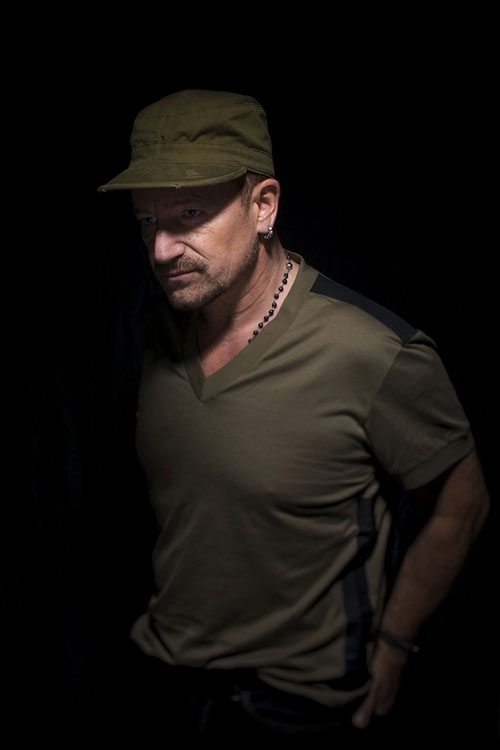
TID:
Thanks, Jay, for speaking about this image and your experience.
Please tell us a little bit about your role at your newspaper.
JAY:
I'm a staff photographer at the L.A. Times, with the majority of
my assignments being portraits and a large number of those
being celebrity portraits. This particular assignment was for a
portrait of U2 front man, Bono, for our award-season insert section
"The Envelope." Bono had written the song "Winter" for the movie
Brothers, and I was tasked with making a cover image, and at least
one other scenario/look for inside. I also have to thank fellow staffer
Liz O. Baylen for NOT being available to shoot this, so that I got the call...
TID:
Before we start talking about the featured image, tell us a little
more about what it's like for you to photograph famous people.
JAY:
It's been a long and winding road BACK to my hometown of L.A.
I always had an affection for Hollywood and the ability to create
illusions - and now that's the majority of the work I do. Portraits
have always been a favorite challenge of mine in photography.
During my time at the Hartford Courant (just under four years), my
first newspaper job after college, I covered everything. It was around
2000 that my editor at the time, Bruce Moyer, re-introduced me to
the 4x5 camera, and encouraged me to take his camera out and shoot
feature section assignments with it. I was hooked.
It made me slow down. No motordrive. I had to interact more with
my subject and direct them. There were very few opportunities for
"found" moments since I had to TELL a subject they couldn't move after
I focused the camera.
I began focusing on portraiture and after leaving the Courant for New
York City, then some time in Washington, D.C. covering politics, I made
it known that I was interested in portrait assignments. When I began
talking to the L.A. Times in the spring of 2007, they were interested
in my feature projects and portraits, which is the majority of what I
shoot now.
TID:
Please tell us how you prepared for the assignment.
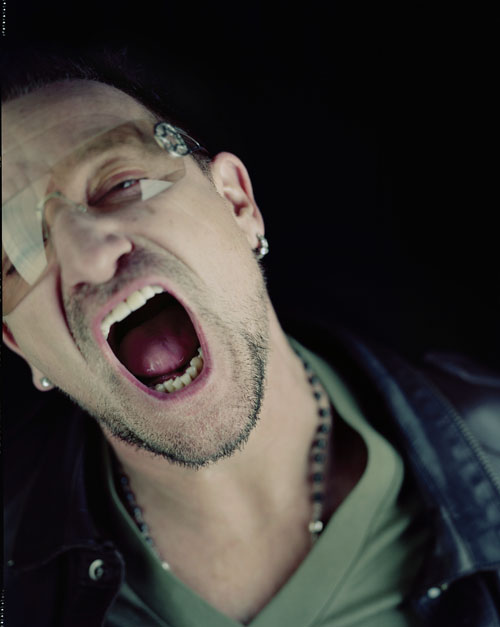
JAY:
I approach all my portraits with the same commitment to
not make someone look bad (attempting to take into account
their insecurities or privacy issues), but I will say I am less tolerant
of impatient/rude/demanding "celebrity" subjects than of non-
celebrities. When someone crosses over that line of obscurity and
become "famous," they become a professional in our/their world
(media/pop culture).
When someone from the L.A. Times, or any media outlet, is coming to
take their picture, I see this as two professionals working together to make a
picture. Sometimes my vision and the celebrity's, or more often the
celeb's publicist's vision, can be in great contrast with each other,
which leads to the sociological aspect of doing portraiture. I always try
to look up a subject's history (www.imdb.com) and scan their shows
and awards to see if there are any bad subjects to bring up, things I
should avoid.
With Bono, since I am a huge fan of U2, I was pretty confident I could go
the safe route and just ask him about his music. My celebrity shoots are
usually completed under 10 minutes. While I will talk a little while
shooting, the longest exchange is often the introduction, when I try to
analyze their greeting and our first couple exchanges to see if I'm able to
break the ice (and possibly convince them of an idea I have.)
With Bono, my number one challenge/goal, was to get a shot of him
without the famous glasses. This was MY goal, as a creative artist. My
editors rarely give direction for these shoots, other than to remind me
to leave room for type, etc. In researching him, I knew there were few
pictures of him without the amber glasses, so that was at the top of my list.
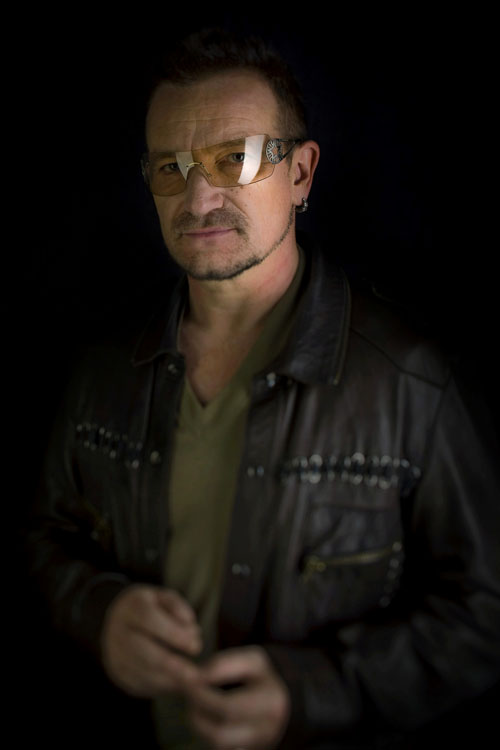
TID:
Ok, now onto the image. Describe what happened when you
first met him and how you handled the beginning of the shoot?
JAY:
I arrived about two hours early to his hotel to feel out the publicist
and approach the subject of no glasses. I was immediately shut down.
She was adamant that the "story" I was there to shoot for was about
his song for the movie, not a "Bono revealed," piece. With that in my
head, we headed to the room and I began my set-up which took about
45 minutes. During that time, an army of people were on hand for
clothing, make-up, assistance... which added chaos. He walked in and
was incredibly sweet and humble, immediately making his way to me
and reaching out to shake hand, ahead of the usual publicist introduction.
He asked me what I wanted to do, and I described my ideas: fairly moody
lighting because it was a somber movie/theme, a couple scenarios, and a
couple clothing options if possible. He gave me a nod of approval and we
started. That's when the trouble began.
TID:
I learned that at one point he looked at what you
were shooting and he didn't like it. How did you handle
that, and how did you move forward?
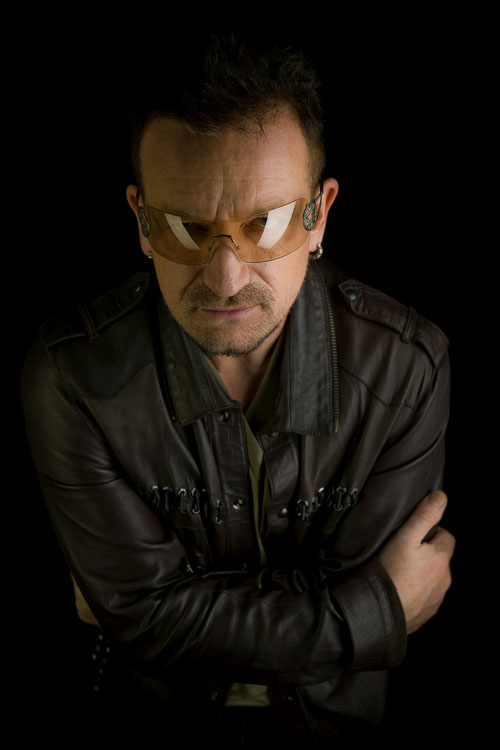
JAY:
YES! I shot about 10 frames in my first lighting scenario and he
asked to see them. He looked and then made a sound of disapproval,
"Hmmm." I started to sweat. "I don't like it. I don't like it at all." My
heart sank and panic set in. I've had publicists kill an idea before, but
to have a subject not like what I was doing - especially someone I admire
so much - I felt defeated. I started to pick up the pieces, and then said,
"OK. What did you have in mind?" From that point on, we worked as a team.
I shot a few frames and we looked at the pictures together, changing his
position, adjusting the lighting. I would say all my portrait shoots are a
collaboration, but this time I was definitely being guided more than I was
directing.
It's always a delicate dance creating portraits, because subjects always
have a reason for wanting their picture taken, but we have to come
to a common ground on WHAT picture we make together. The more
well-known a subject, often the more control they exert over their image,
which can differ from the image I was hoping to make in our 10 minutes
together!
After going back-and-forth with Bono, he suggested we do some without
his glasses. I fought the urge to celebrate! "Sure," I said, "We could try that,
if you want..." After a couple digital frames, I grabbed my 4x5 (a zone VI
field camera) and loaded my last frame of color polaroid. I was psyched
because I was able to get a clean polaroid, my LAST polaroid, of the scenario
I had hoped for. It ended up being our inside lead image.

I want to mention that I feel like having my 4x5 in the room, within view when
the subject walks in, has usually benefitted me by adding a couple extra
minutes to the shoot. Subjects seem to appreciate the "art" of shooting the
"old-fashioned" camera and film, when there isn't the typical instant
gratification. The mystery has an excitement to it, but for me, I love slowing
down the process of making an image. There is much more interaction
with the subject. I concentrate more on the frame and the moment than
I think I do with the motor drive (5D MKII.. What, 3 frames in a burst?)
TID:
I'm curious about the periphery of the shoot. I'm assuming
a lot of people, some handlers of Bono, were around. How
do you handle working with them as well?
JAY:
The Bono shoot wasn't as crazy as some shoots, in terms of other
people in the room. As I mentioned, because they were performing
in town a couple days later, there was extra chaos, with a couple
clothing racks and stylists on hand, but they were all very respectful
of my time with him. Once we started shooting, everyone disappeared
with only the publicists staying within ear-shot. That was actually
a rarity, in my experience. I think it says something about Bono.
Most publicists stand nearby, if not right behind me, so they can
give their "input" during the shoot.
My impression is Bono knows exactly what HE is willing to give for each
photo shoot and he can be (and was) direct in his opinions. A good
publicist knows they're not going to speak over him, and so she let me
have my time with him alone. If anything, on this shoot, I might have been
trying to win the publicist to MY side if things hadn't smoothed over when
he said he didn't like what I was doing!
TID:
You don't have a lot of time with people like Bono. How do you
mentally prepare to make a good image in such a short time.
JAY:
It's true. Even at the L.A. Times, we only get about 10 minutes to make
our pictures. In fact, I will often get cut short of my allotted time, where
as a writer is rarely (never?!) cut short during an interview. I find this
hilarious, considering a picture on the cover of a section is what gets the
most attention.
To answer the question, I don't know if I'm actually mentally prepared
when I go into my assignment. I try not to think about anything more than
assuming I'll only get 10 minutes to work. I usually think about making a
picture with strobes and another with ambient light. I try to imagine two
scenarios, knowing I can usually make 20-30 frames of a scenario (with
a willing subject). It's become a bit of a reflex. When I get a portrait
assignment, Bono included, beyond an IMDB check, I usually check
google images to see what's out there, so I don't repeat something. That's
NOT to say I won't try to "improve upon" an image I find! Lighting becomes
the biggest weight on my mind. Because I'm shooting primarily portraits,
I feel pressure to mix up my lighting and space out similar lighting scenarios.
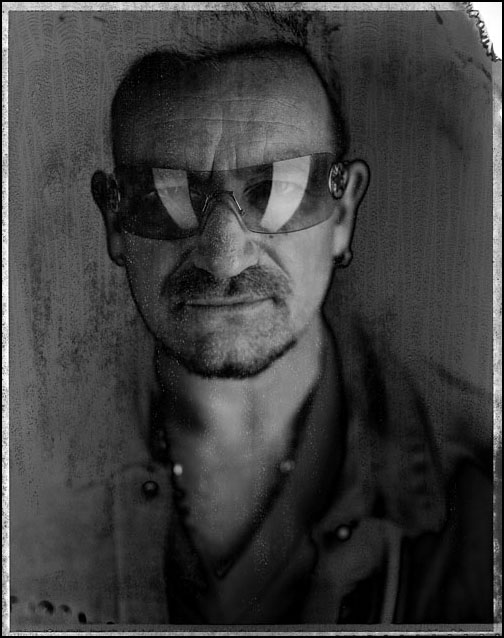
(This is a 4x5 image, shot with my favorite film, the now extinct, Polaroid
Type-55. The "spots" across the image are caused by the drying up of the
chemicals and the uneven application across the piece of film. I've been
milking my last couple boxes, with the film used on this shoot being about
1.5 years past it's expiration date!)
TID:
What surprised you about working with Bono?
JAY:
Bono was surprisingly sweet and easy to work with. As I've said in the
past, it was a sure highlight of my career so far. I've shot a fair number
of subjects who would be considered "A-list," but with that categorization
can come a list of issues. People often flex a tighter grip on their image,
publicists are more demanding and everyone is usually late!
NONE of that was the case with Bono, it was all easy and enjoyable.
TID:
What did you learn that you didn't know before?
JAY:
Hmm. Well, I think getting him to the point where HE suggested
trying a shot without his glasses, highlighted for me the idea that
you shouldn't completely give up on an idea just because a publicist
tries to squash it! The dance I do with publicists, trying to remind them
that I'm here for the L.A. Times and not shooting their publicity photo,
is a delicate one, with lots of smiling and agreement. In the end,
I really want the subject to hear my idea and decide if they want to try
it or not. My idea is the EXACT reason a publicist is there - to keep their
client from doing anything THEY don't think is good for their image.
But my name goes under the subject's face, I don't
want something that looks bad either.
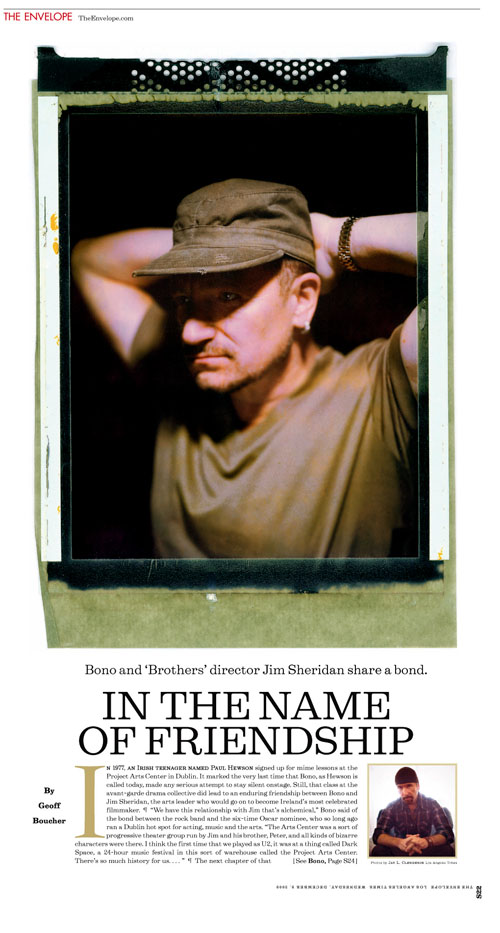
TID:
I'm assuming things sometimes go wrong. How
do you problem solve on short notice?
JAY:
Yes! I've had several close calls with disaster. I think the most
important thing to remember is showing confidence when the
sh@t hits the fan. Whether it means moving on quickly to your
other idea when you explode a neon peacock while shooting in
the office of an NBC executive (yes, it happened), or suggesting a
different body position when your first idea nearly sends Tom
Cruise out a second-story window (that dude has superhuman
speed!). Staying calm and giving the impression that all is going
as you planned, will help keep everyone on your side.
Making a face at the back of the camera when you don't like
something or taking too long to compose, gives the impression
that you aren't sure of your idea, or worse, yourself. I always
want everyone in the room to think I've done this 1,000 times,
and there is no reason to doubt me, so that when something
LOOKS like it is going wrong, I can re-direct their attention to
another idea.
That's the mental stuff. I also think it's really important to have a
checklist that I'm reviewing in my head. I go over my camera
gear, review what i'm thinking about for lighting and figure out what
film and holders I may need. When I get to the hotel/location I'll be
shooting, I do the same review as I'm loading my cart. In my experience,
most problems, beyond something having to do with the actual location of
the shoot, have to do with not having some piece of gear. Be it extension
cords (I have 1-100ft, 2-25ft, 2-splitters) or lights (5 heads total, 3 Canon
strobes) or pocket wizards (5 total), or my trusty canon 45mm TS lens.
I take everything in with me. I also make a point to see what lighting
options I have when I enter a location. It may be arranged that
we're in a hotel room, but I always survey the lobby and any outdoor
spaces, hallways and the room, all while paying attention to what
available light there is and where my power outlets might be.
TID:
Moving forward, how do you see your work evolving?
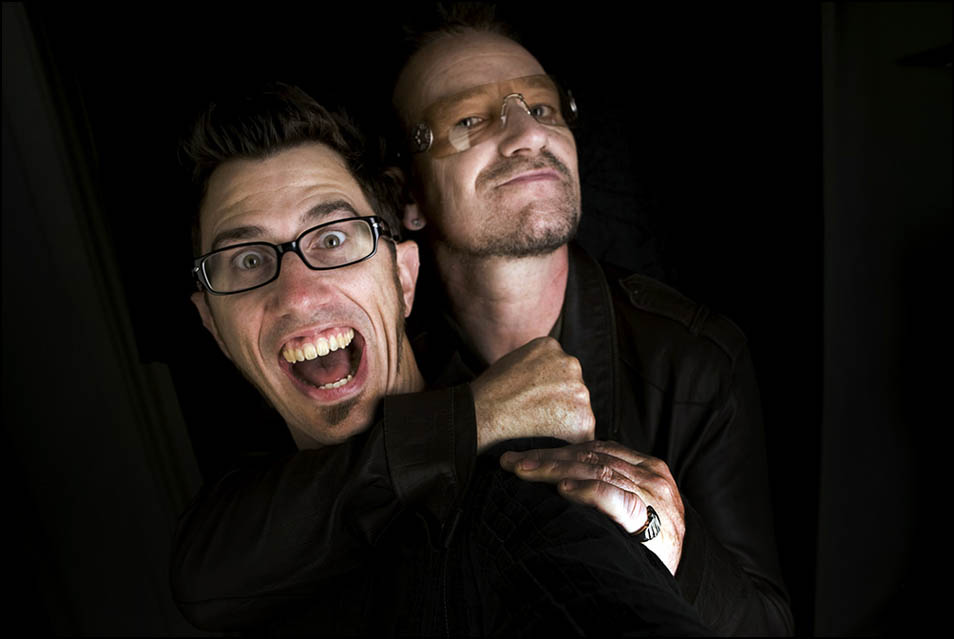
JAY:
Wow, that's DEEP! Look, I am psyched knowing that I get paid to make
pictures and lucky enough to be at a place that lets me concentrate on the
work I like doing. I hope our industry can continue to flex and bend and
my job will still be around in the distant future. Every day I get a new
subject and share a new experience, not just with the subject I work with,
but with a pretty big audience that I wouldn't have if it weren't for the LAT.
I'm definitely excited by the idea that technology is changing the way we
deliver what we do at the newspaper. I haven't tackled much motion yet,
but I am constantly amazed by my co-worker Liz Baylen and the pieces she
produces using stills, audio and video. Hopefully I can get her to teach me
some of her magic in the coming year?!
TID:
In conclusion, what advice do you have for photographers?
JAY:
As I look back on where I've been and what I've been lucky enough to
shoot since leaving San Jose State in '98, I think I would say, be honest
with yourself about the type of photographer you want to be. It sounds
hokey, but it's something I think is really important in growing as a
photographer and in turn, as a person. In my 20s, I wanted to "do it
all," including running off to cover war and hoping to be a James
Nachtwey. But time passed, and after shooting a little bit of everything,
(minus war/foreign strife), I realized I really liked portraiture and
working one-on-one with people in an environment where I had some
control.
Even after leaving a newspaper and freelancing for anyone who would
hire me, I came back to mostly editorial work, because there is always
a variety of subjects and assignments, and the historical aspect of our
documentation is so stimulating. There was definitely a time when
jealousy would creep up inside me when someone around me flew off
for a cool assignment in a remote corner of the world, but that is long
gone. I feel like I've found my niche and I'm very happy to focus on that
exclusively. I'm confident that I am capable of doing just about any
assignment out there, but I don't feel the need to "prove" it any more.
I think people should be confident in what they choose to pursue, but be
self-aware and mindful of opinions from others they trust.
Today, one of the most valuable aspects of my job is that it allows me
to be done with work and home almost every night in time to tuck
my daughter into bed. I've come to realize as I've gotten older (matured?
never!) that my priorities have changed. Competing for awards is a great
way to mark the years of my career, but sharing life-experiences with my
wife and daughter far outweigh a collection of trophy boxes gathering dust
in the garage.
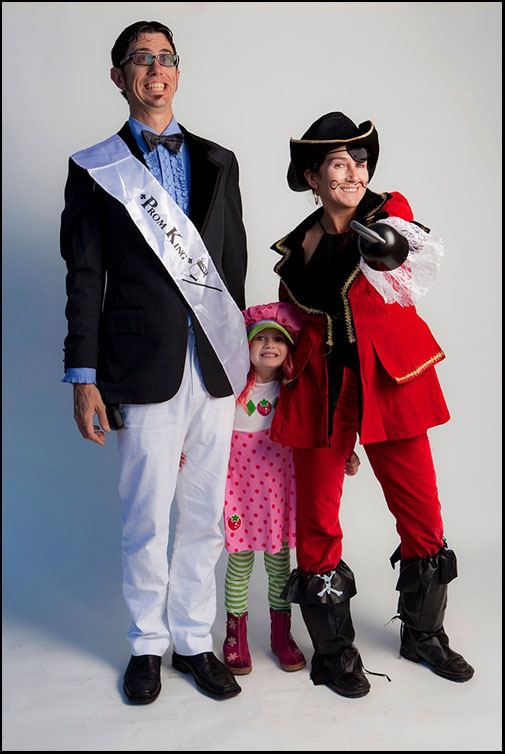
EDITOR'S NOTE:
All Bono photos are copyright of Los Angeles Times.
+++++
Jay L. Clendenin has been a staff photographer at the L.A. Times since October, 2007. To see more of Jay's work:
http://framework.latimes.com/search/clendenin
+++++
Next week we'll take a look at the weird world of Sol Neelman:
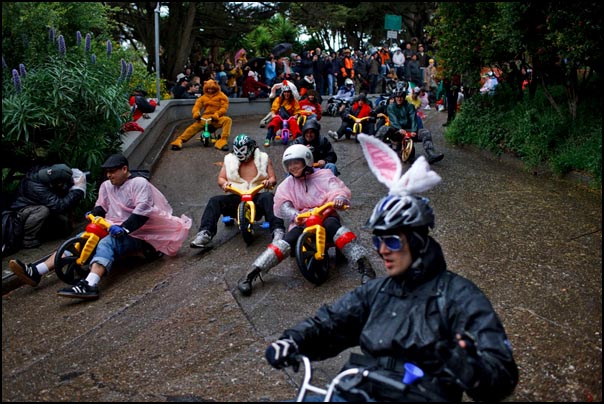
As always, if you have a suggestion of someone, or an image you
want to know more about, contact Ross Taylor or Logan Mock-Bunting:
[email protected]
[email protected]
For FAQ about the blog go to: